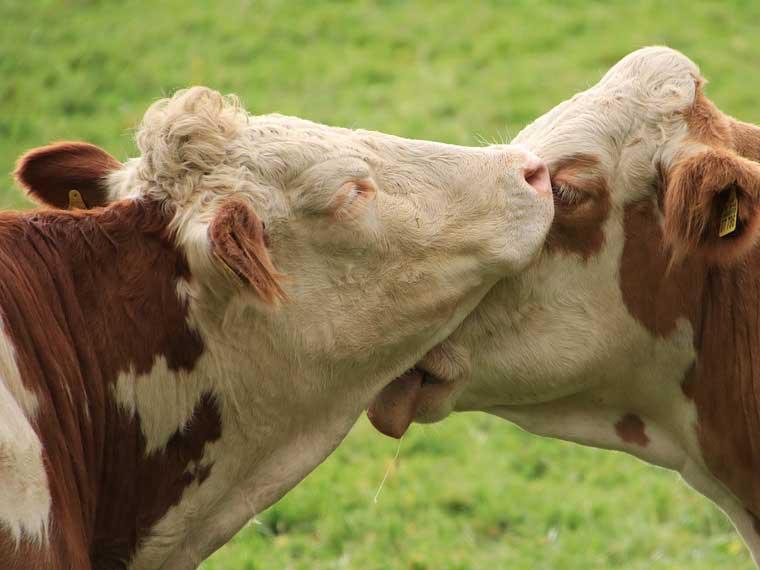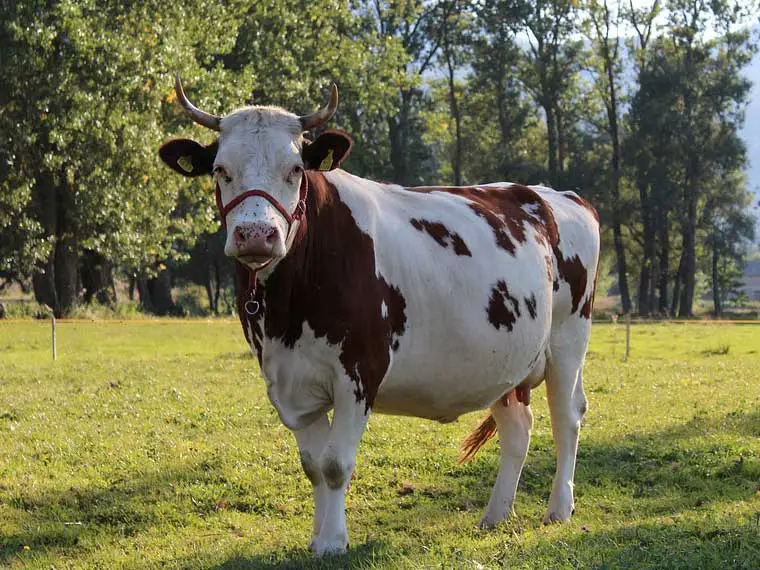Of all the potential pets you can own, a cow is possibly one of the most challenging due to the land and care required. So, with that in mind here’s all you need to know about how a cow can be a good pet with pros and cons listed – but the short and most generic answer first…
Do cows make good pets? Cows do not make good pets due to the expenses involved, the land needed, the mess, and how they ideally need another cow being sociable creatures. I do not recommend you make a pet of a cow.
The pros and cons to keeping a cow as a pet
The short answer above is a very generic opinion on whether cows can make good pets. It may well be very different for you. The pros and cons shown below could help you make that decision.
Cons and disadvantages to keeping cows as pets
Cows are huge animals. As obvious as that sounds, this is the main consideration for anyone thinking making a cow their pet. The average cow weighs between 1,200 and 1,500 pounds. Even miniatures cows can weigh from 800 and1,000 pounds.
That’s a lot of cow, a lot of space, a lot of food, therefore: a lot of expense, particularly when you consider what I am next about to say.
Cows are sociable animals and will not enjoy living alone. So, you should consider either letting your cow live in the house with you (joke) or collect a barnyard of equally sociable ‘pets’, or… acquire another cow which is the best option.

But with that comes more expensive and care.
A cow’s life is not exactly scintillating. Each day, a lactating cow will consume 40 gallons of water, which takes approximately one hour to drink. It spends a further 8 hours grazing and 5 hours actually eating.
For the remaining 10 hours, it lies around, either resting or chewing the cud.
That doesn’t make cows the best of pets if you’re after something that will want to interact and play with you. If you want an exciting animal friends, cows do not make good pets.
And there’s the land you need to let them graze. It would be cost-effective to allow your cow to graze on fresh grass but this means she will need space in which to move around and find sufficient fodder.
A cow and calf combination requires at least two acres of pasture. This land needs to be divided into paddocks and managed effectively so that patches of the more lush grass do not become overgrazed.
You will also need sturdy fences around the perimeter, and to demarcate the paddocks. Cows believe that the grass is always greener on the other side of the fence and will use their considerable weight to try to get there.
That’s more cost and another reason I think cows are not good pets… are you starting to agree?
Then there’s the seasonality changes.
For example, in winter, your pasture will not yield enough nutrients for your cow to eat, so you will need to supplement her food by providing hay or winter feed, such as lucerne.
Your pet cow will also need 35 to 40 lbs of food, per day, in order to generate enough energy to ward off the cold. Lactating and pregnant cows will eat an additional ten percent.
If you don’t have the money, cows do not make good pets.
Then there’s their health.
Your cow’s diet also needs to be supplemented with salt licks, which provide her with all the trace elements and minerals that her body needs. The approximate cost of feeding one cow for one year is $600.
Handy Hint: Here are some safe vegetables you can feed to a pet cow.
The food and water has to be stored until needed and replenished often so that madam does not have to eat stale food. Besides storage infrastructure you will need water troughs and food mangers for daily access.
Cows are somewhat impervious to rain and cold weather but they prefer coming into a safe environment at night, surrounded by their friends. You will need to provide adequate long term shelter for extreme weather conditions.
During the warmer months they will seek shade so either plant some trees or provide undercover shelter.

All the substance your cow consumes each day makes it way, as regular as clockwork, through the animal, out the back end and onto the grass, ground or floor of its shelter.
Thankfully, only about 5 gallons of water makes it out as urine, but this is accompanied by 12 to 18 pats of cow poo. Expect the consistency to vary seasonally, with each change of diet.
Your cow’s stall will most likely need a daily mucking out and bedding change.
Do you still think a cow could make a good pet? Well, if you have a weak stomach and don’t have the motivation to clean up a lot of mess, then definitely not.
The bottom line is, owning a pet cow is incredibly expensive, if you expect to be able to milk it. You may be able to bid on an unwanted bull calf at auction but he will need copious amounts of milk to raise him to the weaning stage.
Males come with additional challenges, such as the inability to yield any milk, and testosterone induced aggression which is usually solved only by neutering.
Cows only produce milk in order to feed their offspring. To ensure a steady supply of milk, you will need your cow to calve at least once a year. It would not make sense to feed and house a moody bull just so that he can service one cow, once a year.
Artificial insemination is a viable alternative but may be expensive.
Milking a cow is not an easy skill to learn, even if the cow is willing. She may object to your cold hands early in the morning, or anything else that comes to mind, and kick the bucket, negating all your hard work. It is not the most comfortable of activities and, if you have a miniature cow you will have to sit on the floor to milk it.
And this one is so important…
You will need to have access to the services of a vet who can deal with large animals and understands the quirks of livestock. Not all common vets will have the ability to help with your pet cow.
Then there’s possible transporting a cow to and from the vet is costly and requires a sturdy trailer and a powerful engine to pull it. You are better off paying the vet’s call out rate.
You may regard your docile cow as a pet but the authorities see her as a link in the food chain and she will be subject to reams of red tape. She will be registered in a regional or national database, and be subjected to annual inspections, either by your own vet or the state veterinary authorities.
She will need to have a long list of annual vaccinations and inoculations against viral and bacterial infections, and a host of parasites.
If you live in a residential area, it may not be zoned for bovine lodgings. Cows make several noises. They moo, grunt and snort, but by far their loudest and longest sound is the distress call or bellow. Mothers can hear their calves calling from 2 miles away or more.
If you have sensitive neighbours, who desire peace and quiet, they may not take kindly to this noise – or the amount of flies your pet cow will attract.
Cows are not always omnivorous. They have been known to eat eggs and small animals, including barnyard kittens. They are also not always docile. Cattle kill more people worldwide than sharks do.
Around 20 people are killed in the USA each year, roughly one third by bulls, another third by cows and the remainder by stampeding herds. Most of these attacks are deliberate.
Riding a cow is not as much fun as riding a horse, or even a donkey. They are exceedingly slow and uncomfortable to mount. You will be better off sitting side saddle.
And that is why I don’t believe cows make very good pets.
But some people do, so to offer you both sides of the story, here’s what people who own pet cows say to me about them making good pets.
Pros and advantages to keeping cows as pets
If you’re still convinced that you would like a cow as a pet, there are a number of factors in its favour.
Cows are intelligent, curious and affectionate beasts that can be taught to indulge you in cuddling sessions. They respond to commands and can be trained easily. It has even been noted that they can be house trained.
Cows have a mothering instinct and get on well with most barnyard animals. They are often trusted by other livestock to protect them.
They are generally docile, unless you have acquired one with murderous intent that stares at you, or one that has been waylaid by a vicious gang of mad cows.
Cattle in general do not mind inclement weather, and are equally tolerant of summer heat. You can keep them outside in all but the worst weather conditions.
They do not appear as bedraggled as sheep or shiver like donkeys. Their hides are thoroughly waterproof and do not require grooming.
Your pet cow could live to be 15 to 20 years old if she is well cared for. In return she will deliver calves for many seasons and, as a by-product, give you milk from which you can make cream, butter and cheese.
As mentioned previously, she will provide you with copious amounts of fresh manure, all year round, as well as a plentiful supply of uric acid.
What about specific breeds of cows as pets?
Do highland cows make good pets?
Whilst Highland cows are friendly, that doesn’t mean they make good pets. Just like another breed of cow, a Highland cow requires a lot of expertise, land, money, and care if kept as a pet. I don’t recommend Highland cows as pets.
Do miniature cows make good pets?
Keeping mini or miniature cows pets is a little different given their size. You won’t need as much land, but if you do keep a mini cow as a house pet please have more than one so they have company. As with any cow though, I still don’t recommend keeping miniature cows as pets.
Do Jersey cows make good pets?
As you’ve guessed by now, I don’t agree with keeping Jersey cows as pets due to their size and what you need to have to take care of them. So, to simply conclude, I don’t believe Jersey cows make good pets.
Conclusion
The idea of faithful Bessy, your pet cow, out in the backyard, greeting you cheerfully and gleefully offering up a few gallons of milk each morning, is the dream of many who long to live in the country.
The reality though is very different. It is difficult to bring this picture to life in an area that is not zoned for agricultural use.
Technically speaking, a pet is an animal kept primarily for companionship or entertainment. Working animals and livestock do not qualify as pets.
Bessy may woo you with her liquid brown eyes, but there are many more factors mitigating against keeping a cow as a pet than there are pros.
I firmly believe that you should reconsider getting a cow to keep as a pet.
You might also like…
Image of pet cows in the header via https://pixabay.com/photos/mammal-farm-yard-farm-animals-3305320/


